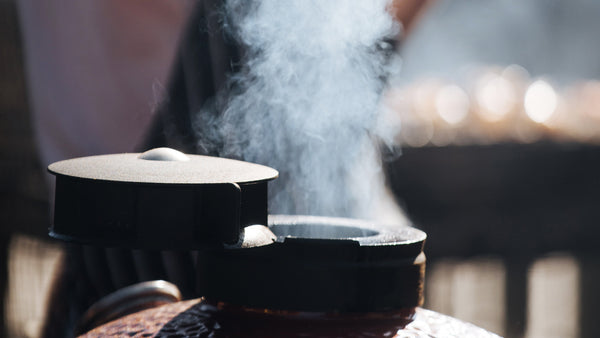
BBQers and Smokers: Understanding the Science of Smoke and Meat
Smoking meat is more than just a culinary tradition—it's a fascinating interplay of chemistry, physics, and technique that transforms simple cuts into BBQ masterpieces. By understanding the science of smoking meat, you can elevate your results, making every brisket or rack of ribs not just good, but truly exceptional.
The Anatomy of Smoke: What’s Happening in Your Smoker
Wood Combustion & Smoke Composition:
When wood burns, its core components—cellulose, hemicellulose, and lignin—break down, releasing a complex mix of compounds. Phenols, formed during lignin combustion, are key to smoky flavor and act as antioxidants, preserving meat and extending its shelf life. Aldehydes and organic acids contribute to the Maillard reaction (the browning and flavor development on the meat’s surface) and help preserve and color the meat. Alcohols and esters add complexity, while hydrocarbons, produced during incomplete combustion, can cause bitter flavors and even pose health risks. The key is to balance these elements for optimal flavor and safety.
Clean Smoke vs. Dirty Smoke:
-
Thin blue smoke is nearly invisible and signals efficient combustion, producing the best flavor and minimal unwanted compounds.
-
Thick white or gray smoke means incomplete combustion, often due to excess moisture or poor airflow, and can impart bitter, acrid notes to your BBQ.
-
Black smoke is a warning sign of severe oxygen deficiency, leading to extremely bitter flavors and higher levels of undesirable hydrocarbons.
Managing airflow and temperature is crucial for achieving clean smoke—see How to Control Temperature in a Kamado Grill.
How Smoke Interacts with Meat: Flavor, Color & Bark
Smoke Flavor Penetration:
Smoke compounds are absorbed at the meat’s surface, especially where moisture and fat are present. Moist surfaces (from spritzing or water pans) help smoke adhere, but deep penetration is limited—most flavor is surface-level.
BBQ Smoke Ring Explained:
That coveted pink ring beneath the surface of smoked meat is a result of nitric oxide (NO) and carbon monoxide (CO) from wood combustion binding with myoglobin, the protein responsible for meat’s red color. Low-and-slow cooking gives these gases time to react before myoglobin denatures at around 160–170°F, “fixing” the pink hue just under the bark. The smoke ring is a visual hallmark, not a guarantee of flavor or tenderness.
Maillard Reaction & Bark Formation:
The Maillard reaction is a chemical process between amino acids and sugars, creating the complex, savory flavors and deep brown crust (bark) on smoked meat. Bark forms from a combination of smoke particles, rub adhesion, dehydration, and the Maillard reaction, with airflow playing a vital role in its development.
The Science of Meat Transformation: Tenderness and Juiciness
Collagen Breakdown & Gelatinization:
Tough cuts like brisket and ribs are rich in collagen, a connective tissue that, when exposed to low-and-slow heat (160–205°F), breaks down into gelatin, making the meat tender and juicy. High-heat cooking, by contrast, contracts collagen, resulting in toughness.
Fat Rendering:
Slow smoking melts intramuscular fat, adding both moisture and flavor to the meat.
The Stall:
During long cooks, meat temperature may plateau (“the stall”) as surface moisture evaporates, cooling the meat. Wrapping the meat or increasing humidity can help push through this phase.
Fueling the Science: Wood Types and Charcoal
Wood Type & Flavor:
Different woods (hickory, oak, apple, cherry, pecan, mesquite) yield unique smoke profiles due to variations in lignin and cellulose content. Choose wood size and species to match your desired smoke intensity and flavor—see "Choosing Wood Size: Chips, Chunks, Logs."
Charcoal’s Role:
High-quality lump charcoal is essential for clean, consistent heat and smoke. Learn more in What Charcoal is Best for Kamado Grills?.

Applying the Science: Practical Tips
-
Temperature Control: Maintain steady, low heat for optimal collagen breakdown and clean smoke.
-
Airflow Management: Adjust vents for thin blue smoke—see How to Setup for Smoking on a Kamado Grill.
-
Moisture Management: Use water pans and spritzing to keep the meat’s surface moist for better smoke adhesion.
-
Accurate Monitoring: Use reliable thermometers to track both grill and internal meat temperatures.
-
Patience: The science of smoking takes time, but the results are worth it.
Conclusion: Master the Science, Master the Smoke
Understanding the science of smoking meat—from wood combustion and smoke chemistry to collagen breakdown and bark formation—will transform your BBQ results. Apply these principles with Vessils grills and accessories for consistently mouth-watering, competition-worthy barbecue.
